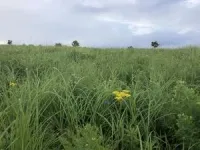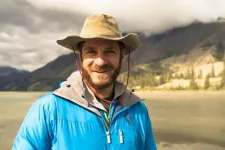(Press-News.org) As grasslands get abandoned, controlled burning is discussed as a labor-saving method of keeping forests at bay. A Kobe University research team found that this method results in higher biodiversity and a higher prevalence of endangered plant species in some grasslands compared to others, depending on what soils they grow on.
Humans have been keeping grasslands since millennia by grazing, mowing and controlled burning, all of these are means to keep forests from overgrowing the grasslands. Grazing and mowing are, however, labor intensive and as rural areas become increasingly depopulated, grasslands have been disappearing worldwide. One consequence of this is the loss of the habitat of plant and insect species, also many endangered ones, that depend on grasslands. To maintain grasslands nevertheless, “prescribed” burning, which is what land managers call controlled burning, is being discussed as a labor-efficient option. But not all grasslands are equal. The Kobe University ecologist USHIMARU Atushi says, “Many studies have focused on examining the effects of different management measures on plant diversity, but few researchers have paid attention to those of soil differences.” Therefore, it has remained unclear which soils are better candidates for being managed by prescribed burning in terms of allowing a high diversity of endangered plants or plant species in general.
To settle this question, Ushimaru’s team led by master’s student ASADA Airi turned to Mount Fuji. There, on a training site of the Japan Self-Defense Forces, grasslands covering different soil types are kept by prescribed burning once a year in April. “We noticed that there were some areas, especially on young lava flows, where endangered species were concentrated,” Ushimaru explains the choice of the research site, allowing them to study which soil factors influence species abundance. On site, they set up 100 one-square-meter plots across the grasslands on four different soil types and in each identified all plants as well as measured a range of physical and chemical factors.
Their results, now published in the journal Plants, People, Planet, show that grasslands on young lava flows exhibit higher total species richness, native species richness and prevalence of red-listed plant species than grasslands on both young and old scoria bedrock. They also found that the soils were different in their acidity, depth and coverage by rocks and stones, which allowed them to infer that these factors are important to the persistence of rare plants.
Previous studies showed that acidic soils make it difficult for plants to take up nutrients and shallow soils favor slow-growing plants. Asada thus argues that, as prescribed burning resets plants growth on the grasslands, these conditions suppress the growth of otherwise fast-growing and thus dominant species and so give those that are usually outcompeted and that are therefore rare a better chance of gaining a foothold.
Ushimaru sums up, “Our study was able to identify environments where grasslands managed by burning alone can harbor a significant variety of endangered species.” The team concludes their paper saying, “Identifying environments where high plant diversity can be maintained through prescribed burning not only elucidates the survival conditions of grassland plants in Japan but also proves essential for the conservation and restoration of grassland environments and grassland species in the future.”
This research was funded by the Japan Society for the Promotion of Science (grants 19H03303 and 24K01782) and the Environmental Restoration and Conservation Agency (grant JPMEERF20234005). It was conducted in collaboration with researchers from the J. F. Oberlin University.
Kobe University is a national university with roots dating back to the Kobe Higher Commercial School founded in 1902. It is now one of Japan’s leading comprehensive research universities with nearly 16,000 students and nearly 1,700 faculty in 10 faculties and schools and 15 graduate schools. Combining the social and natural sciences to cultivate leaders with an interdisciplinary perspective, Kobe University creates knowledge and fosters innovation to address society’s challenges.
END
Burn grasslands to maintain them: What is good for biodiversity?
2025-01-31
ELSE PRESS RELEASES FROM THIS DATE:
Ventilation in hospitals could cause viruses to spread further
2025-01-31
Increased use of ventilation and air cleaners, designed to mitigate the spread of viral infections in hospitals, is likely to have unpredictable effects and may cause viral particles to move around more, according to a new study from researchers at UCL and UCLH.
In the study, published in Aerosol Science & Technology, researchers investigated the effect of using built-in mechanical ventilation and portable air cleaners (PACs)1 upon the spread of airborne particles, which are similar to those breathed ...
New study finds high concentrations of plastics in the placentae of infants born prematurely
2025-01-30
UNDER EMBARGO UNTIL: Jan. 30, 2025, 3:30 p.m. MST
Media Contact: Karen Addis, APR, karen@addispr.com, +1 (301) 787-2394
Denver, Colo. ― Microplastics, which are less than 5 millimeters, and nanoplastics, which are invisible to the naked eye, are widespread throughout our environment. Research has shown that exposure to plastics in general is harmful to both the environment and humans.
Now, in a new study to be presented today at the Society for Maternal-Fetal Medicine’s (SMFM) annual meeting, The Pregnancy Meeting™, researchers will unveil findings that suggest that microplastics and nanoplastics have been found ...
New robotic surgical systems revolutionizing patient care
2025-01-30
SALT LAKE CITY— Huntsman Cancer Institute at the University of Utah (the U) proudly announces the addition of two da Vinci 5 robotic surgical systems. This state-of-the-art technology is designed to enhance precision, control, and safety during minimally invasive surgeries, setting a new standard in patient care. These advancements align with Huntsman Cancer Institute’s focus on successfully delivering world-class cancer care through innovative treatments.
“This is a significant leap forward in robotic surgery,” says Brian Mitzman, MD, MS, FACS, FCCP, Huntsman ...
New MSK research a step toward off-the-shelf CAR T cell therapy for cancer
2025-01-30
CAR T cell therapy is one of the most promising new cancer treatments to emerge in recent years. It involves removing a patient’s own immune T cells and engineering them to recognize specific targets on the surface of the cancer cell.
A major limitation of this type of CAR T cell therapy, called autologous therapy, is that the cells are taken from the patient and must be custom-made into a treatment. This requires patients to wait until their cells are modified for infusion — precious time they may not have.
Now research done at Memorial Sloan ...
UTEP professor wins prestigious research award from American Psychological Association
2025-01-30
EL PASO, Texas (Jan. 30, 2025) – Health sciences researcher Emre Umucu, Ph.D., associate professor and associate dean for research at The University of Texas at El Paso, has been awarded the Roger G. Barker Distinguished Research Contribution Award from the American Psychological Association (APA). The award honors research in the field of rehabilitation psychology, which focuses on helping individuals with disabilities and chronic conditions improve their health, independence and social participation.
“I am ...
New national study finds homicide and suicide is the #1 cause of maternal death in the U.S.
2025-01-30
UNDER EMBARGO UNTIL: Jan. 30, 2025, 2:45 p.m. MST
Media Contact: Karen Addis, APR, karen@addispr.com, +1 (301) 787-2394
Denver, Colo. -- In the medical community, research has traditionally focused on how to prevent and treat the leading medical causes of maternal mortality, which include bleeding, infection, hypertension, and cardiovascular disease. However, new research reveals deaths by homicide and suicide are the leading causes of maternal death in the United States.
In a study to be presented today at the Society for Maternal-Fetal ...
Women’s pelvic tissue tears during childbirth unstudied, until now
2025-01-30
Millions of women undergo episiotomies during childbirth every year, yet the mechanics behind these surgical cuts remain largely unstudied. A new research project is poised to change that, addressing this significant gap in women’s health.
An episiotomy involves cutting the pelvic-floor muscles to aid delivery, a technique currently guided largely by a surgeon’s personal judgment and experience. While intended to prevent severe vaginal tears or other complications during delivery, the procedure itself can lead to lasting pain, incontinence, infection, ...
Earth scientists study Sikkim flood in India to help others prepare for similar disasters
2025-01-30
Experts from the global Earth science community – including a scientist from the University of Calgary – have pieced together what happened during the massive Sikkim flood to try to help others prepare for similar disasters.
On Oct. 3, 2023, a multi-hazard cascade in the Sikkim Himalaya, India, was triggered by a permanently frozen (permafrost) lateral moraine – debris from erosion along a glacier – collapsing into South Lhonak Lake.
“A landslide went into a lake and that triggered a wave that eroded a dam at the end of the lake, which resulted in a slurry-like flood for hundreds of kilometres,” explains Dr. Dan ...
Leveraging data to improve health equity and care
2025-01-30
Rush is developing an innovative data platform to improve the health of Chicagoans. Funded by a $7.5 million grant from the Searle Funds at the Chicago Community Trust, the project will fortify Rush’s data science infrastructure and create a research network to improve quality and equity in health care.
“We believe everyone should have the chance to be healthy,” said John Rich, MD, MPH, the Harrison I. Steans Director of the RUSH BMO Institute for Health Equity. “Yet, we know from medical literature that certain groups receive ...
Why you shouldn’t scratch an itchy rash: New study explains
2025-01-30
Your parents were right: Scratching an itchy rash really does make it worse. Now we know why, thanks to new research published today in the journal Science that uncovers how scratching aggravates inflammation and swelling in a mouse model of a type of eczema called allergic contact dermatitis.
“At first, these findings seemed to introduce a paradox: If scratching an itch is bad for us, why does it feel so good?” said senior author Daniel Kaplan, M.D., Ph.D., professor of dermatology and immunology at the University of Pittsburgh. “Scratching is often pleasurable, which suggests ...







